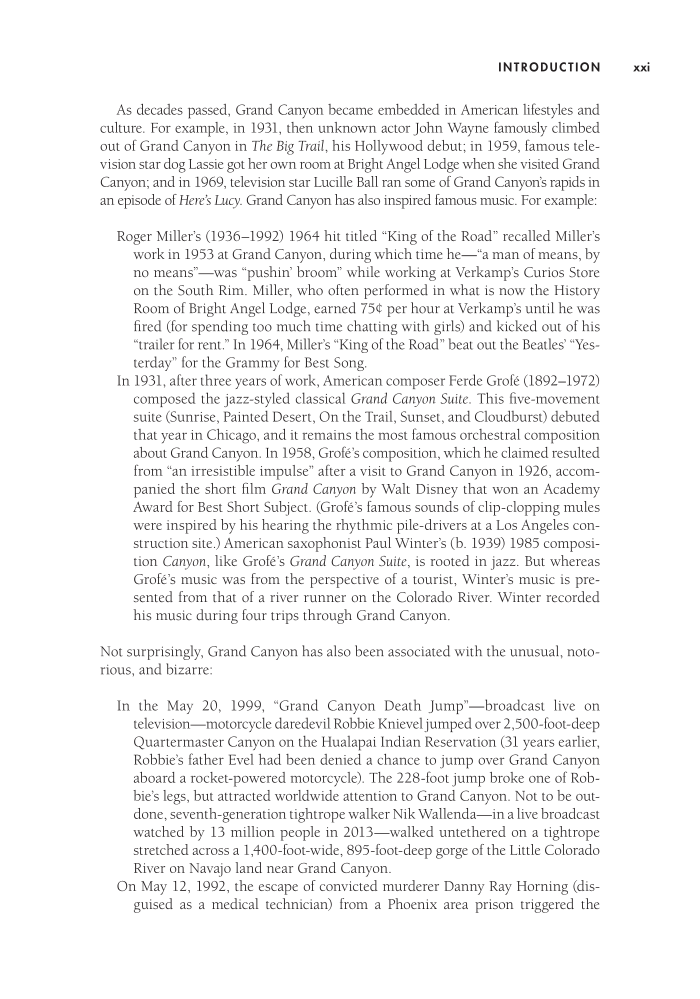Introduction xxi As decades passed, Grand Canyon became embedded in American lifestyles and culture. For example, in 1931, then unknown actor John Wayne famously climbed out of Grand Canyon in The Big Trail, his Hollywood debut in 1959, famous tele vision star dog Lassie got her own room at Bright Angel Lodge when she visited Grand Canyon and in 1969, tele vi sion star Lucille Ball ran some of Grand Canyon’s rapids in an episode of Here’s Lucy. Grand Canyon has also inspired famous music. For example: Roger Miller’s (1936–1992) 1964 hit titled “King of the Road” recalled Miller’s work in 1953 at Grand Canyon, during which time he—“a man of means, by no means”—was “pushin’ broom” while working at Verkamp’s Curios Store on the South Rim. Miller, who often performed in what is now the History Room of Bright Angel Lodge, earned 75¢ per hour at Verkamp’s until he was fired (for spending too much time chatting with girls) and kicked out of his “trailer for rent.” In 1964, Miller’s “King of the Road” beat out the Beatles’ “Yes- terday” for the Grammy for Best Song. In 1931, after three years of work, American composer Ferde Grofé (1892–1972) composed the jazz-styled classical Grand Canyon Suite. This five-movement suite (Sunrise, Painted Desert, On the Trail, Sunset, and Cloudburst) debuted that year in Chicago, and it remains the most famous orchestral composition about Grand Canyon. In 1958, Grofé’s composition, which he claimed resulted from “an irresistible impulse” after a visit to Grand Canyon in 1926, accom- panied the short film Grand Canyon by Walt Disney that won an Academy Award for Best Short Subject. (Grofé’s famous sounds of clip-clopping mules were inspired by his hearing the rhythmic pile-drivers at a Los Angeles con- struction site.) American saxophonist Paul Winter’s (b. 1939) 1985 composi- tion Canyon, like Grofé’s Grand Canyon Suite, is rooted in jazz. But whereas Grofé’s music was from the perspective of a tourist, Winter’s music is pre- sented from that of a river runner on the Colorado River. Winter recorded his music during four trips through Grand Canyon. Not surprisingly, Grand Canyon has also been associated with the unusual, noto- rious, and bizarre: In the May 20, 1999, “Grand Canyon Death Jump”—broadcast live on television—motorcycle daredevil Robbie Knievel jumped over 2,500-foot-deep Quartermaster Canyon on the Hualapai Indian Reservation (31 years earlier, Robbie’s father Evel had been denied a chance to jump over Grand Canyon aboard a rocket-powered motorcycle). The 228-foot jump broke one of Rob- bie’s legs, but attracted worldwide attention to Grand Canyon. Not to be out- done, seventh-generation tightrope walker Nik Wallenda—in a live broadcast watched by 13 million people in 2013—walked untethered on a tightrope stretched across a 1,400-foot-wide, 895-foot-deep gorge of the Little Colorado River on Navajo land near Grand Canyon. On May 12, 1992, the escape of convicted murderer Danny Ray Horning (dis- guised as a medical technician) from a Phoenix area prison triggered the
Document Details My Account Print multiple pages
Print
You have printed 0 times in the last 24 hours.
Your print count will reset on at .
You may print 0 more time(s) before then.
You may print a maximum of 0 pages at a time.

























































































































































































































































































































































































































































